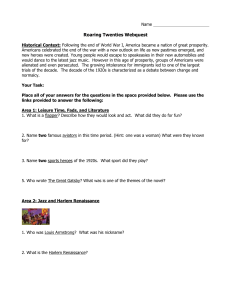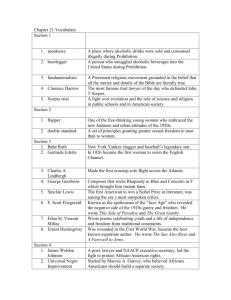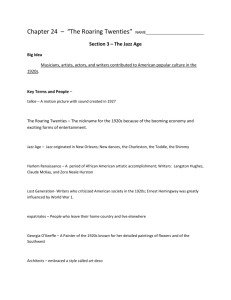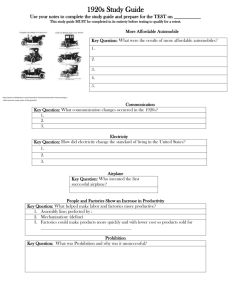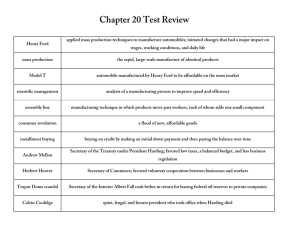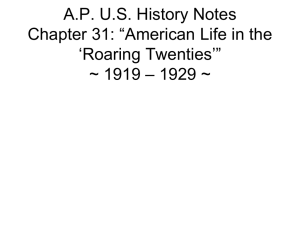Roaring 1920s
advertisement
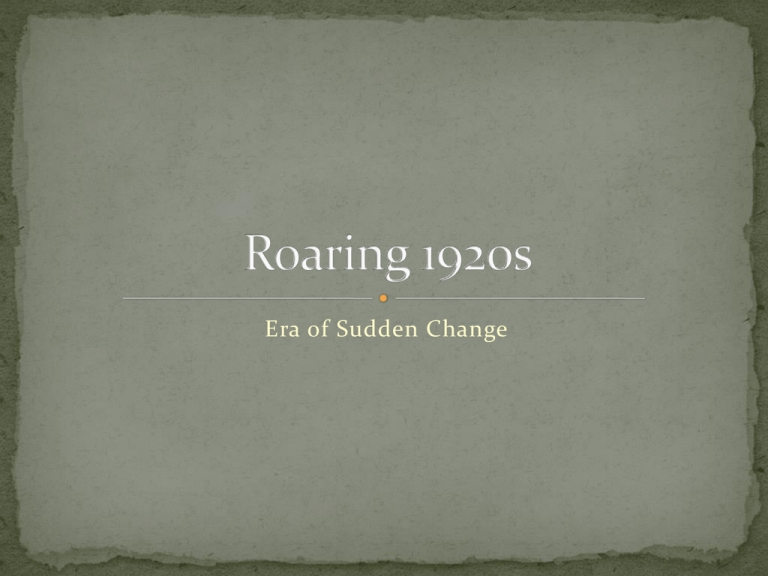
Era of Sudden Change Role of Women: 19th Amendment – Women get right to vote – 1920 First woman governor in Wyoming – Nellie Tayloe Ross Women voting had little impact – voted same as husband Work place changes – during boom of 1920s women went back to work Still held most of lowest paying jobs College attendance went up among middle and upper class women Still was caretaker of home – sought more equality with men Flappers emerge – young women who defied traditional values of women Primarily found in large cities Angered many of traditional women’s rights groups – did not like image Urbanization – the movement of people from the farms to the city Causes of rise of urbanization Farm life was hard and farmers were poor 1920s saw the first time more people lived in urban areas Rise of automobiles Increase in education – grew with growth of industry Effects of Urbanization: Caused a shift in values of Americans – value warfare between urban and rural people Caused growth in Ku Klux Klan Rise of Fundementalism – literal interpretation of Bible Famous preachers: Billy Sunday, Aimee Semple McPherson Famous Court Case of Fundementalism – Scopes Trial Christian Creationism vs. Evolution Clearance Darrow vs. William Jennings Bryan Prohibition – made the national law by the 18th Amendment Prohibition restricted making, distributing, and selling of alcohol Volstead Act – law enforcing prohibition Problems with Prohibition: Drinking alcohol was still legal Those who wanted it could still get it – created smuggling rings Organized crime groups (mobsters) rose – Al Capone Saw creation of speakeasies – illegal bars Bootlegging become a major business – smuggling of alcohol People made their own alcohol – moonshiners Doctors prescribed medicinal alcohol Government spent a great deal of money on stopping alcohol Causes: Great Migration – Started in 1910 Blacks moved from South to North looking for freedom Moved to neighborhood in Manhattan (New York City) called Harlem Still found racism in the North – Chicago riot of 1919 Many blacks felt military service earned them rights/freedom Inspiration of Renaissance W.E.B DuBois – started magazine called The Crisis Magazine was outlet promoting African writing and poetry Marcus Garvey – started Universal Negro Improvement Association which promoted a “Back to Africa” movement Charged with mail fraud went to prison and then deported from country Harlem Renaissance – explosion of art, writing, music, and entertainment from the African American culture of Harlem. Writers and Poets: common theme was black defiance to white oppression James Weldon Johnson – wrote book of poetry called God’s Trombones Langston Hughes Claude McKay Artists: work focused on experiences of African Americans William H. Johnson Aaron Douglas Jacob Lawrence Performers and Musicians Paul Robeson – actor, singer Josephine Baker – actor, singer, dancer Louis Armstrong – major jazz musician Jazz got its start in Harlem Renaissance – blended music that was mostly improvised Other artists: Cab Calloway, Duke Ellington, Fats Waller, Bessie Smith Driven by new media: broke down old barriers that separated the nation Radio – brought radio shows and music into homes Movies became feature films with themes D.W. Griffith – made Birth of a Nation Became equipped with sound Jazz Singer Animated movies were born Walt Disney – Steamboat Willie featured Mickey Mouse 1920s becomes era of heroes – all walks of life Film stars – Charlie Chaplain, Rudolph Valentino, Clara Bow, Mary Pickford, Douglas Fairbanks Jr. National Heroes: Charles Lindbergh – first to have transatlantic flight Amelia Earhart – first woman to fly across Atlantic Disappeared trying to fly around the world Sports Heroes: Red Grange – football player “Galloping Ghost” Helen Willis – tennis player Bobby Jones – golfer Babe Ruth – baseball – ushered in Golden Age of Baseball Writers: themes focused on things going on during the age F. Scott Fitzgerald – wrote The Great Gatsby (rich vs. poor) Sinclair Lewis – wrote Babbitt (middle class life) Ernest Hemmingway – writer impacted by World War I Wrote Farewell to Arms Women were also writers Edna St. Vincent Millay – poetry Willa Cather and Edith Wharton – novelists Music writers George Gershwin – wrote Rhapsody in Blue

